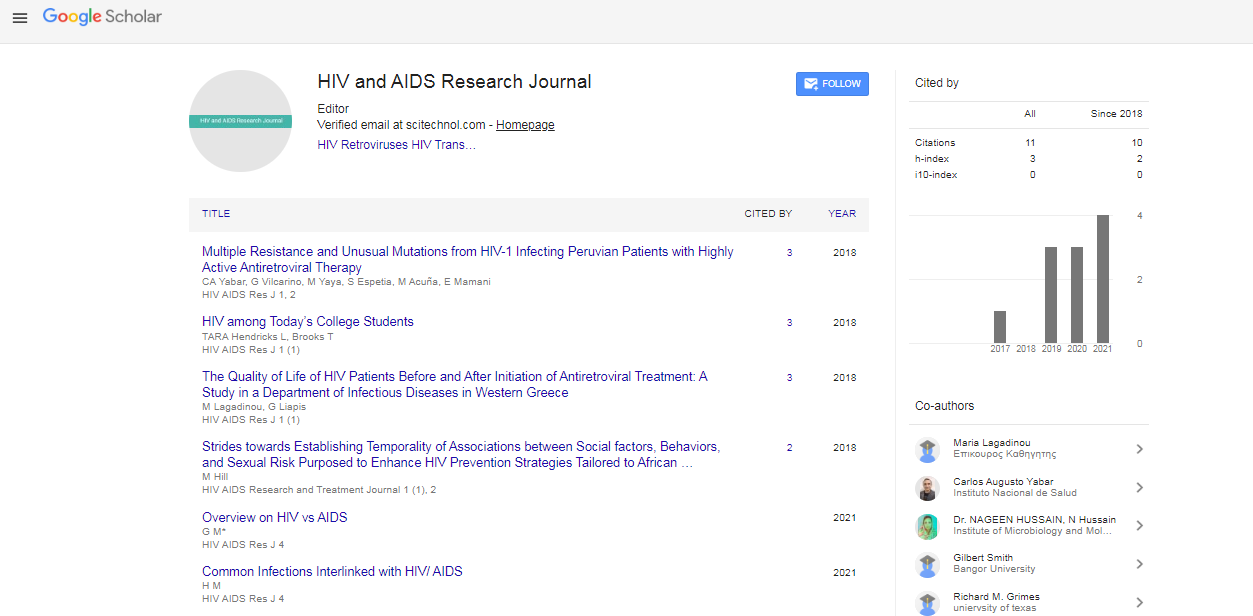About the HIV and AIDS Research Journal
HIV and AIDS Research Journal is a peer reviewed journal that focuses on the advancements in the research of HIV and AIDS, clinical trials, vaccination, health conditions, and preventive measures. This Journal considers almost all aspects of basic research and biomedical science and social issues related to HIV and AIDS. The Journal mainly focuses on testing, diagnosis, infection transmission, replication, sexually transmitted infections, clinical therapy and case studies.
HIV is the retrovirus which attacks the immune system by killing the white blood cells in the immune system known as CD4 cells. It makes more copies of itself in body by killing CD4 cells. As a result the person who is attacked with HIV will be vulnerable to infections and leads to death. Medications may suppress the virus but there is no cure for it.
Submit Manuscript using Online Submission System system or send as an e-mail attachment to us at manuscripts@scitechnol.com
The following classifications and topics related to it will be considered for publication in the HIV and AIDS Research Journal but, not limited to the following fields:
- HIV Retroviruses
- HIV Transmission
- HIV Infection
- AIDS Research
- Immune System and HIV
- HIV Replication
- HIV Life Cycle
- HIV Symptoms
- HIV Clinical Therapies
- HIV Complications & Risk Behaviors
- Advanced HIV Infection preventive measures
- Innovative HIV Drugs & Drug Resistance
- HIV Counseling
- Highly Active Antiretroviral Therapy
- HIV Vaccines
All the published articles are open access and can be accessed online without any subscription fees and the articles will receive the benefit of worldwide visibility. The Journal follows quality peer review process and provides easy access to the authors to track the process of manuscript evaluation and publication in an automated way. The received manuscripts undergo double blind review process by the board members of HIV and AIDS Research Journal. However, approval of at least two independent reviewers and the editor is mandatory to accept the manuscript for citable publication to maintain quality.
HIV Retroviruses
Human Immuno deficiency Virus belongs to a group of retroviruses called lentiviruses. HIV is a retrovirus having RNA but not DNA, with the help of reverse transcriptase enzyme the RNA transcribes in to DNA after entering host cell. HIV can only replicate itself within living cells of the host. The HIV virus infects cells of the immune system and affects the hosts ability to fight off invaders that seek to compromise the immune system and thereby cause health problems.
HIV Transmission
HIV is transmitted through bodily fluids such as blood, semen, vaginal secretion and breast milk from an infected person. One can only get HIV if infected persons bodily fluids enter in to non infected person. The different modes of HIV transmission are through unprotected sex, sharing needles, mother to child in uterus or by breast feeding and unhygienic blood transfusions. HIV is not transmitted through sweat, saliva, tears and urine.
HIV Infection
HIV is the virus that attacks the immune system also called as the body natural defense system by entering into the blood through bodily fluids. This virus will attack the CD4 cells and destroys them, as a result the body defense mechanism will get weaker. This condition gradually destroys the immune system which makes it harder for the body to fight against infections. Person who have infected with HIV may not have any disease symptoms up to 10 years but they can pass the infection to others. HIV infection can be tested by ELISA test and western blot test.
AIDS Research
AIDS is the final stage of HIV infection. A person who is said to have AIDS when the person infected with HIV has two or more infectious diseases like tuberculosis, pneumonia. This means the person will have very low level of CD4 cells, so vulnerable to infections and infectious diseases. AIDS research includes drug development, vaccination, pre exposure prophylaxis and post exposure prophylaxis. From the past 20 years many researches are going on AIDS, still there is no cure for it.
Immune System and HIV
Immune system is defined as the body's ability to protect against harmful micro organisms like virus and bacteria. When an HIV is entered in to the body it gradually disrupts immune system by killing the CD4 cells in lymph nodes. The virus levels in the lymph nodes and blood increases constantly. As a result CD4 cells count will be reduced and it leads to imbalance in the body's immune system. HIV weakens the immune system and thus the person attacked by HIV is vulnerable to dangerous infections and diseases. By using few medicines one can suppress the virus, but it's not completely curable.
HIV replication
HIV replication is defined as the multiplication of the virus in host body.HIV replication is carried out is seven steps they are: Viral entry, Reverse transcription, Nuclear import, Integration, Assembly, Budding, Maturation. HIV can only replicate itself in human body. HIV once entering into host cell using the reverse transcriptase enzyme transcripts RNA in to DNA and then integrated in to the CD4 cell DNA, HIV uses the body of CD4 cell to make long chains of HIV proteins. Proteins are the building blocks of HIV and thus it is replicated.
HIV Life cycle
The HIV Life cycle includes the complete steps from the starting entry of the virus in to a person's body till the infected persons death. Once after the entry of virus into the body it completes whole replication process to multiple it self in the host body. So that HIV becomes strong and destroys immune system. There are several stages in HIV life cycle that can take years to show the impact on host body. Using medications can suppress the HIV but there is no cure for it. HIV life cycle helps the scientists to study when the virus will be weak in the host body to reduce its multiplication in the host body.
HIV Symptoms
The symptoms of recent HIV infection is difficult to identify apart from the symptoms of viral infections. Many people with recent HIV infection doesn't notice symptoms. In few people HIV may slowly damage immune system without any symptoms. However, these are the symptoms of HIV infection. Fever, Fatigue, Achy muscles, joint pain, swollen lymph nodes, sore throat, headache, skin rashes, nausea, vomiting, diarrhea, weight loss, dry cough, pneumonia, night sweats, nail changes, yeast infections, confusion or difficulty concentrating, cold sores, genital herpes, tingling weakness, menstrual irregularities.
HIV Clinical Therapies
HIV Clinical Therapy is also known as antiretroviral therapy. It is the use of medicines to treat HIV infection. People on HIV clinical therapy take combination of HIV medicines every day called as HIV regimens. This HIV clinical therapy is recommended for every person infected with HIV. This therapy will not cure HIV, but this can help the person infected with HIV live longer. This also reduces the risk of HIV transmission. Medications to treat HIV are classified based on their mechanism of actions. Currently, more than 20 individual compounds in 6 different classes are known and over 30 different formulations have been approved by FDA.
HIV Complications & Risk Behaviors
HIV weakens the immune system and makes highly susceptible to numerous infections and certain types of cancers. Generally HIV complications don't occur if a persons CD4 is higher than 500 cells per cubic millimeter. The different HIV complications are bacterial pneumonia, fugal infections, tuberculosis, mycobacterium avium complex and candidiasis are the main complications found with HIV. Risk behaviours of HIV infection are having multiple sex partners, unprotected sex with strangers, injecting drugs or steroids by sharing needles, having sexually transmitted infections.
Advanced HIV Infection preventive measures
Medications can control the growth of HIV infection but, it is not completely curable. Prevention of HIV is better than cure. The different kinds of preventive measure are using a new condom every time having sex, knowing yours and your partners HIV status, limiting the number of sexual partners, using new needles for the injectable drug use, taking medical care immediately after suspected HIV exposure.
Innovative HIV Drugs & Drug Resistance
Currently many biopharmaceutical companies conducting researches on invention of drug to cure HIV. Most of the innovated drugs are in clinical trials and are awaiting for FDA approval. At present there are few classes of drugs which can suppress the virus they are: Nucleoside/Nucleotide Reverse Transcriptase Inhibitors (NRTIs), Non-nucleoside Reverse Transcriptase Inhibitors (NNRTIs), Protease Inhibitors (PIs), Fusion Inhibitors, CCR5 Antagonist, integrate Inhibitors, Fixed-Dose Combinations. The above classified drugs can control the growth of virus but due to drug resistance of HIV it is not completely curable.
HIV Counseling
Counseling in HIV had became important element in the health care. It is also recognized as integral to patient management. The aim of HIV counseling is to prevent HIV transmission and to support those who affected by the HIV directly or indirectly. HIV counseling plays a major role because spread of HIV can be prevented by the individual behavior. When patients know that they have HIV infection, they suffer with a lot of psychological stress, fear of rejection, social stigma and uncertainties with future management of HIV.
Highly Active Antiretroviral Therapy
Highly Active Antiretroviral Therapy is also known as HAART. After invention of Highly Active Antiretroviral Therapy doctors and scientists were able to witness a 50% drop in the number of AIDS-related deaths in the U.S. and Europe. HAART is the combination of three of more drugs given to the infected person. This can suppress the different types of HIV effectively, if one drug is unable to suppress a certain viral type, one or both of the other agent would be helpful. Even with triple combination of drugs few viruses are undetectable which circulates in the bloodstream and mutate in to a resistance strain.
HIV Vaccines
HIV vaccines will help the people to prevent the virus for those who are not infected with HIV. These are given with the goal to prevent the HIV in future. As of now there are no such preventive vaccines approved by FDA. Many researchers are conducting researches on the HIV preventive vaccines. Scientists are experiencing trouble to inventing vaccine because HIV is highly mutable and it has ability to respond rapidly to the selective pressures imposed by the immune system.
Fast Editorial Execution and Review Process (FEE-Review Process):
HIV and AIDS Research Journal is participating in the Fast Editorial Execution and Review Process (FEE-Review Process) with an additional prepayment of $99 apart from the regular article processing fee. Fast Editorial Execution and Review Process is a special service for the article that enables it to get a faster response in the pre-review stage from the handling editor as well as a review from the reviewer. An author can get a faster response of pre-review maximum in 3 days since submission, and a review process by the reviewer maximum in 5 days, followed by revision/publication in 2 days. If the article gets notified for revision by the handling editor, then it will take another 5 days for external review by the previous reviewer or alternative reviewer.
Acceptance of manuscripts is driven entirely by handling editorial team considerations and independent peer-review, ensuring the highest standards are maintained no matter the route to regular peer-reviewed publication or a fast editorial review process. The handling editor and the article contributor are responsible for adhering to scientific standards. The article FEE-Review process of $99 will not be refunded even if the article is rejected or withdrawn for publication.
The corresponding author or institution/organization is responsible for making the manuscript FEE-Review Process payment. The additional FEE-Review Process payment covers the fast review processing and quick editorial decisions, and regular article publication covers the preparation in various formats for online publication, securing full-text inclusion in a number of permanent archives like HTML, XML, and PDF, and feeding to different indexing agencies.
 Spanish
Spanish  Chinese
Chinese  Russian
Russian  German
German  French
French  Japanese
Japanese  Portuguese
Portuguese  Hindi
Hindi 




